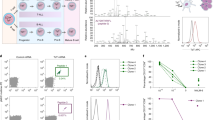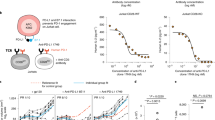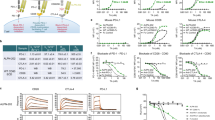Abstract
Although CD4+ helper T lymphocytes have been demonstrated to play an important role in antitumor immune response, only a few epitopes of tumor-associated antigens recognized by HLA class II-restricted CD4+ T lymphocytes have been identified. In the present study, we addressed the question of whether leukemia-associated fusion proteins are recognized by CD4+ T lymphocytes. Immature dendritic cells (DCs) were loaded with necrotic or apoptotic leukemia cells with t(6;9) or t(9;22) and then cocultured with the dek-can fusion peptide-specific or the bcr-abl fusion peptide-specific CD4+ T lymphocyte clone. The dek-can peptide-specific and bcr-abl peptide-specific CD4+ T lymphocyte clones produced interferon-γ (IFN-γ) when they were cocultured with HLA-DR-matched but not with mismatched DCs which had been loaded with apoptotic as well as necrotic leukemia cells with t(6;9) and t(9;22), respectively. IFN-γ production by CD4+T lymphocyte clones in response to stimulation with DCs loaded with leukemia cells was inhibited by the anti-HLA-DR monoclonal antibody. These data indicate that the acute myelogenous leukemia-associated fusion protein, dek-can, and chronic myelogenous leukemia-associated fusion protein, bcr-abl, are both processed and presented by DCs to the fusion peptide-specific CD4+ T lymphocytes.
This is a preview of subscription content, access via your institution
Access options
Subscribe to this journal
Receive 12 print issues and online access
$259.00 per year
only $21.58 per issue
Buy this article
- Purchase on Springer Link
- Instant access to full article PDF
Prices may be subject to local taxes which are calculated during checkout






Similar content being viewed by others
References
Klarnet JP, Kern DE, Okunu K, Holt C, Lilly F, Greenberg PD . FBL-reactive CD8 cytotoxic and CD4 helper T cells recognize distinct Friend murine leukemia virus-encoded antigens J Exp Med 1989 169: 457–467
Hu J, Kindsvogel W, Busby S, Bailey MC, Shi Y, Greenberg PD . An evaluation of the potential to use tumor-associated antigens as targets for antitumor T cell therapy using transgenic mice expressing a retroviral tumor antigen in normal lymphoid tissues J Exp Med 1993 177: 1681–1690
Yoshimura A, Shiku H, Nakayama E . Rejection of an IA+ variant line of FBL-3 leukemia by cytotoxic T lymphocytes with CD4+ and CD4−CD8− T cell receptor-αβ phenotypes generated in CD8-depleted C57BL/6 mice J Immunol 1993 150: 4900–4910
Giralt S, Hester J, Huh Y, Hirsch-Ginsberg C, Rondon G, Seong D, Lee M, Gajewski J, van Besien K, Khouri I, Mehra R, Przepiorka D, Korbling M, Talpaz M, Kantarjian H, Fischer H, Deisseroth A, Champlin R . CD8-depleted donor lymphocyte infusion as treatment for relapsed chronic myelogenous leukemia after allogeneic bone marrow transplantation Blood 1995 86: 4337–4343
Wang R-F, Wang X, Atwood AC, Topalian SL, Rosenberg SA . Cloning genes encoding MHC class II-restricted antigens: mutated CDC27 as a tumor antigen Science 1999 284: 1351–1354
Chaux P, Vantomme V, Stroobant V, Thielemans K, Corthals J, Luiten R, Eggermont AMM, Boon T, van der Bruggen P . Identification MAGE-3 epitopes presented by HLA-DR molecules to CD4+ T lymphocytes J Exp Med 1999 189: 767–777
Manici S, Sturniolo T, Imro MA, Hammer J, Sinigaglia F, Noppen C, Spagnoli G, Mazzi B, Bellone M, Dellabona P, Protti MP . Melanoma cells present a MAGE-3 epitope to CD4+ cytotoxic T cells in association with histocompatibility leukocyte antigen DR11 J Exp Med 1999 189: 871–876
Kobayashi H, Song Y, Hoon DSB, Appella E, Celis E . Tumor-reactive T helper lymphocytes recognize a promiscuous MAGE-A3 epitope presented by various major histocompatibility complex class II alleles Cancer Res 2001 61: 4773–4778
Schultz ES, Lethé B, Cambiaso CL, Van Snick J, Chaux P, Corthals J, Heirman C, Thielemans K, Boon T, van der Bruggen P . A MAGE-A3 peptide presented by HLA-DP4 is recognized on tumor cells by CD4+ cytolytic T lymphocytes Cancer Res 2000 60: 6272–6275
Zeng G, Touloukian CE, Wang X, Restifo NP, Rosenberg SA, Wang RF . Identification of CD4+ T cell epitopes from NY-ESO-1presented by HLA-DR molecules J Immunol 2000 165: 1153–1159
Zeng G, Wang X, Robbins PF, Rosenberg SA, Wang R-F . CD4+ T cell recognition of MHC class II-restricted epitopes from NY-ESO-1 presented by a prevalent HLA DP4 allele: association with NY-ESO-1 antibody production Proc Natl Acad Sci USA 2001 98: 3964–3969
Topalian SL, Gonzales MI, Parkhurst M, Li YF, Southwood S, Sette A, Rosenberg SA, Robbins PF . Melanoma-specific CD4+ T cells recognize nonmutated HLA-DR-restricted tyrosinase epitopes J Exp Med 1996 183: 1965–1971
Kobayashi H, Kokubo T, Sato K, Kimura S, Asano K, Takahashi H, Iizuka H, Miyokawa N, Katagiri M . CD4+ T cells from peripheral blood of a melanoma patient recognize peptides derived from nonmutated tyrosinase Cancer Res 1998 58: 296–301
Zarour HM, Kirkwood JM, Kierstead LS, Herr W, Brusic V, Slingluff CL Jr, Sidney J, Sette A, Storkus WJ . Melan-A/MART-151-73 represents an immunogenic HLA-DR4-restricted epitope recognized by melanoma reactive CD4+ T cells Proc Natl Acad Sci USA 2000 97: 400–405
Hiltbold EM, Ciborowski P, Finn OJ . Naturally processed class II epitope from the tumor antigen MUC1 primes human CD4+ T cells Cancer Res 1998 58: 5066–5070
Touloukian CE, Leitner WW, Topalian SL, Li YF, Robbins PF, Rosenberg SA, Restifo NP . Identification of a MHC class II-restricted human gp100 epitope using DR4-IE transgenic mice J Immunol 2000 164: 3535–3542
Heinzel S, Rea D, Offringa R, Pawelec G . The self peptide annexin II (208-223) presented by dendritic cells sensitizes autologous CD4+ T lymphocytes to recognize melanoma cells Cancer Immunol Immunother 2001 49: 671–678
Nieda M, Nicol A, Kikuchi A, Kashiwase K, Taylor K, Suzuki K, Tadokoro K, Juji T . Dendritic cells stimulate the expansion of bcr-abl specific CD8+ T cells with cytotoxic activity against leukemic cells from patients with chronic myeloid leukemia Blood 1998 91: 977–983
Yotnda P, Firat H, Garcia-Pons F, Garcia Z, Gourru G, Vernant JP, Lemonnier FA, Leblond V, Langlade-Demoyen P . Cytotoxic T cell response against the chimeric p210 BCR-ABL protein in patients with chronic myelogenous leukemia J Clin Invest 1998 101: 2290–2296
Osman Y, Takahashi M, Zheng Z, Koike T, Toba K, Liu A, Furukawa T, Aoki S, Aizawa Y . Generation of bcr-abl specific cytotoxic T lymphocytes by using dendritic cells pulsed with bcr-abl (b3a2) peptide: Its applicability for donor leukocyte transfusions in marrow grafted CML patients Leukemia 1999 13: 166–174
Yotnda P, Garcia F, Peuchmaur M, Grandchamp B, Duval M, Lemonnier F, Vilmer E, Langlade-Demoyen P . Cytotoxic T cell response against the chimeric ETV6-AML1 protein in childhood acute lymphoblastic leukemia J Clin Invest 1998 102: 455–462
Hamaguchi H, Nagata K, Yamamoto K, Fujikawa I, Kobayashi M, Eguchi M . Establishment of a novel human myeloid leukaemia cell line (FKH-1) with t(6;9)(p23;q34) and the expression of dek-can chimaeric transcript Br J Haematol 1998 102: 1249–1256
Lozzio BB, Machado EA, Lozzio CB, Lair S . Hereditary asplenic-athymic mice: transplantation of human myelogenous leukemic cells J Exp Med 1976 143: 225–231
Ohminami H, Yasukawa M, Kaneko S, Yakushijin Y, Abe Y, Kasahara Y, Ishida Y, Fujita S . Fas-independent and nonapoptotic cytotoxicity mediated by a human CD4+ T-cell clone directed against an acute myelogenous leukemia-associated DEK-CAN fusion peptide Blood 1999 93: 925–935
Yasukawa M, Ohminami H, Kaneko S, Yakushijin Y, Nishimura Y, Inokuchi K, Miyakuni T, Nakao S, Kishi K, Kubonishi I, Dan K, Fujita S . CD4+ cytotoxic T-cell clones specific for bcr-abl b3a2 fusion peptide augment colony formation by chronic myelogenous leukemia cells in a b3a2-specific and HLA-DR-restricted manner Blood 1998 92: 3355–3361
Yasukawa M, Inatsuki A, Horiuchi T, Kobayashi Y . Functional heterogeneity among herpes simplex virus-specific human CD4+ T cells J Immunol 1991 146: 1341–1347
Inoue Y, Yasukawa M, Fujita S . Induction of T-cell apoptosis by human herpesvirus 6 J Virol 1997 71: 3751–3759
Ohminami H, Yasukawa M, Fujita S . HLA class I-restricted lysis of leukemia cells by a CD8+ cytotoxic T lymphocyte clone specific for WT1 peptide Blood 2000 95: 286–293
Fujita H, Senju S, Yokomizo H, Saya H, Ogawa M, Matsushita S, Nishimura Y . Evidence that HLA class II-restricted human CD4+ T cells specific to p53 self peptides respond to p53 proteins of both wild and mutant forms Eur J Immunol 1998 28: 305–316
Pardoll DM, Topalian SL . The role of CD4+ T cell responses in antitumor immunity Curr Opin Immunol 1998 10: 588–594
Wang R-F . The role of MHC class II-restricted tumor antigens and CD4+ T cells in antitumor immunity Trends Immunol 2001 22: 269–276
von Lindern M, Fornerod M, van Baal S, Jaegie M, de Wit T, Buijs A, Grosveld G . The translocation (6;9), associated with a specific subtype of acute myeloid leukemia, results in the fusion of two genes, dek and can, and the expression of a chimeric, leukemia-specific dek-can mRNA Mol Cell Biol 1992 12: 1687–1697
Baxevanis CN, Voutsas IF, Tsitsilonis OE, Gritzapis AD, Sotiriadou R, Papamichail M . Tumor-specific CD4+ T lymphocytes from cancer patients are required for optimal induction of cytotoxic T cells against the autologous tumor J Immunol 2000 164: 3902–3912
Mumberg D, Monach PA, Wanderling S, Philip M, Toledano AY, Schreiber RD, Schreiber H . CD4+ T cells eliminate MHC class II-negative cancer cells in vivo by indirect effects of IFN-γ Proc Natl Acad Sci USA 1999 96: 8633–8638
Yasukawa M, Zarling JM . Human cytotoxic T cell clones directed against herpes simplex virus-infected cells. I. Lysis restricted by HLA class II MB and DR antigens J Immunol 1984 133: 422–427
Miyazaki A, Sato N, Takahashi S, Sasaki A, Kohama G, Yamaguchi A, Yagihashi A, Kikuchi K . Cytotoxicity of histocompatibility leukocyte antigen-DR8-restricted CD4+ killer T cells against human autologous squamous cell carcinoma Jpn J Cancer Res 1997 88: 191–197
ten Bosch GJ, Toornvliet AC, Friede T, Melief CJ, Leeksma OC . Recognition of peptides corresponding to the joining region of p210bcr-abl protein by human T cells Leukemia 1995 9: 1344–1348
Pawelec G, Max H, Halder T, Bruserud O, Meri A, da Silva P, Kalbacher H . BCR/ABL leukemia oncogene fusion peptides selectively bind to certain HLA-DR alleles and can be recognized by T cells found at low frequency in the repertoire of normal donors Blood 1996 88: 2118–2124
Bocchia M, Korontsvit T, Xu Q, Mackinnon S, Yang SY, Sette A, Scheinberg DA . Specific human cellular immunity to bcr-abl oncogene-derived peptides Blood 1996 87: 3587–3592
Mannering SI, McKenzie JL, Fearnley DB, Hart DNJ . HLA-DR1-restricted bcr-abl (b3a2)-specific CD4+ T lymphocytes respond to dendritic cells pulsed with b3a2 peptide and antigen-presenting cells exposed to b3a2 containing cell lysates Blood 1997 90: 290–297
ten Bosch GJA, Joosten AM, Kessler JJ, Melief CJM, Leeksma OC . Recognition of bcr-abl positive leukemia blasts by human CD4+ T cells elicited by primary in vitro immunization with a bcr-abl breakpoint peptide Blood 1996 88: 3522–3527
ten Bosch GJA, Kessler JH, Joosten AM, Bres-Vloemans AA, Geluk A, Godtheip BC, van Bergen J, Melief CJ, Leeksma OC . A BCR-ABL oncoprotein p210b2a2 fusion region sequence is recognized by HLA-DR2a restricted cytotoxic T lymphocytes and presented by HLA-DR matched cells transfected with an Iib2a2 construct Blood 1999 94: 1038–1045
Yasukawa M, Ohminami H, Kojima K, Hato T, Hasegawa A, Takahashi T, Hirai H, Fujita S . HLA class II-restricted antigen presentation of endogenous bcr-abl fusion protein by chronic myelogenous leukemia-derived dendritic cells to CD4+ T lymphocytes Blood 2001 98: 1498–1505
Ossendorp F, Mengede E, Camps M, Filius R, Melief CJM . Specific T helper cell requirement for optimal induction of cytotoxic T lymphocytes against major histocompatibility complex class II negative tumors J Exp Med 1998 187: 693–702
Albert ML, Sauter B, Bhardwaj N . Dendritic cells acquire antigen from apoptotic cells and induce class I-restricted CTLs Nature 1998 392: 86–89
Fujii S, Fujimoto K, Shimizu K, Ezaki T, Kawano F, Takatsuki K, Kawakita M, Matsuno K . Presentation of tumor antigens by phagocytic dendritic cell clusters generated from human CD34+ hematopoietic progenitor cells: induction of autologous cytotoxic T lymphocytes against leukemia cells in acute myelogenous leukemia patients Cancer Res 1999 59: 2150–2158
Inaba K, Turley S, Yamaide F, Iyoda T, Mahnke K, Inaba M, Pack M, Subkiewe M, Sauter B, Sheff D, Albert M, Bhardwaj N, Mellman I, Steinman RM . Efficient presentation of phagocytosed cellular fragments on the major histocompatibility complex class II products of dendritic cells J Exp Med 1998 188: 2163–2173
Shaif-Muthana M, McIntyre C, Sisley K, Rennie I, Murray A . Dead or alive: immunogenicity of human melanoma cells when presented by dendritic cells Cancer Res 2000 60: 6441–6447
Sauter B, Albert ML, Francisco L, Larsson M, Somersan S, Bhardwaj N . Consequences of cell death: exposure to necrotic tumor cells, but not primary tissue cells or apoptotic cells, induces the maturation of immunostimulatory dendritic cells J Exp Med 2000 191: 423–433
Acknowledgements
Supported by grants from the Ministry of Education, Culture, Sports, Science and Technology of Japan, the Welfide Medicinal Research Foundation, the Sagawa Cancer Research Foundation, the Cancer Research Foundation, the Yamanouchi Foundation for Research on Metabolic Disorders, the Uehara Memorial Foundation, the Takeda Science Foundation, and the Japan Medical Association.
Author information
Authors and Affiliations
Rights and permissions
About this article
Cite this article
Makita, M., Azuma, T., Hamaguchi, H. et al. Leukemia-associated fusion proteins, dek-can and bcr-abl, represent immunogenic HLA-DR-restricted epitopes recognized by fusion peptide-specific CD4+ T lymphocytes. Leukemia 16, 2400–2407 (2002). https://doi.org/10.1038/sj.leu.2402742
Received:
Accepted:
Published:
Issue Date:
DOI: https://doi.org/10.1038/sj.leu.2402742
Keywords
This article is cited by
-
Neoantigen-specific TCR-T cell-based immunotherapy for acute myeloid leukemia
Experimental Hematology & Oncology (2022)
-
Accurate detection of tumor-specific gene fusions reveals strongly immunogenic personal neo-antigens
Nature Biotechnology (2022)
-
T-cell-based immunotherapy of acute myeloid leukemia: current concepts and future developments
Leukemia (2021)
-
Regulation of hematopoietic and leukemic stem cells by the immune system
Cell Death & Differentiation (2015)
-
Leukemia-associated antigens and their relevance to the immunotherapy of acute myeloid leukemia
Leukemia (2012)



